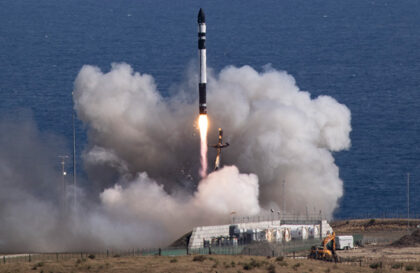Bringing a rocket back from space and catching it with a helicopter is a supersonic ballet. So says Rocket Lab founder and CEO Peter Beck. He is right. Many factors must come together, and many systems must work together flawlessly for a catch to be successful.
Mission “There and Back”
The Electron booster, descending under a parachute (right), as seen from the helicopter as it attempted to grapple the parachute. The helicopter released the booster moments later, though. Credit: Rocket Lab
During the “There and Back Again” mission, Rocket Lab successfully captured the first stage of an Electron rocket returning to Earth for the first time using a Sikorsky S-92 helicopter, using a grappling hook on a long cable to grab a parachute line at an altitude of 6,500 feet (about 2,000 meters). This is an essential step towards creating a reusable Electron rocket for frequent and cost-effective launches of small satellites. Despite the discovery of unexpected loading characteristics, the stage was successfully launched into the water and was sent to Rocket Lab’s manufacturing facility for analysis and preparation for reuse.
Rocket Lab has acknowledged that landing rockets using a propulsion system like SpaceX’s Falcon 9 is impossible for small rockets. Electron is too small to carry the fuel needed for a controlled landing. Therefore, previously, boosters were removed from the ocean after parachute descent. This time, the company focuses on recovering the rockets in the air for possible reuse. This method avoids problems with the rocket coming into contact with salt water.
“Electron” after being caught in the air. Credit: X / Rocket Lab
The mid-air capture of an Electron rocket during Rocket Lab’s There and Back Again mission followed successful water recoveries of the first stage after the 16th, 20th, and 22nd missions. As before, the control system ensured an ideal reentry angle, protecting the stage from extreme heat and pressure. To slow down, a brake and main parachute were used. This mission was the first to test a helicopter hijack attempt, and the experience will be used for future similar operations.
Rocket Lab’s There and Back Mission launched on May 3, 2022 at 10:49 a.m. New Zealand time from Pad A at Launch Complex 1 on the Mahia Peninsula in New Zealand. The mission deployed satellites for Alba Orbital, Astrix Astronautics, Aurora Propulsion Technologies, E-Space, Space Flight, and Invisible Labs, bringing the total number of satellites launched by Rocket Lab to 146.
These satellites are designed for various purposes, including monitoring light pollution, testing space debris removal technologies, improving the energy efficiency of small satellites, testing technologies to avoid collisions with untraceable space objects, providing Internet access from space, and building maritime surveillance systems.
Middle-class rocket
In 2021, Rocket Lab introduced an updated version of its Neutron mid-range rocket, made of carbon composite materials with a 7-meter width at the base. The rocket fairing, without separating during launch, opens into four parts. The first stage has been modified to be reusable within 24 hours of landing and will return to the launch pad rather than a floating barge.
Banner image: An Electron booster returns under chute – envisioned by Mack Crawford for NSF/L2. Credit: NASA SpaceFlight
Image credit:
https://www.nasaspaceflight.com
https://spacenews.com
https://twitter.com

